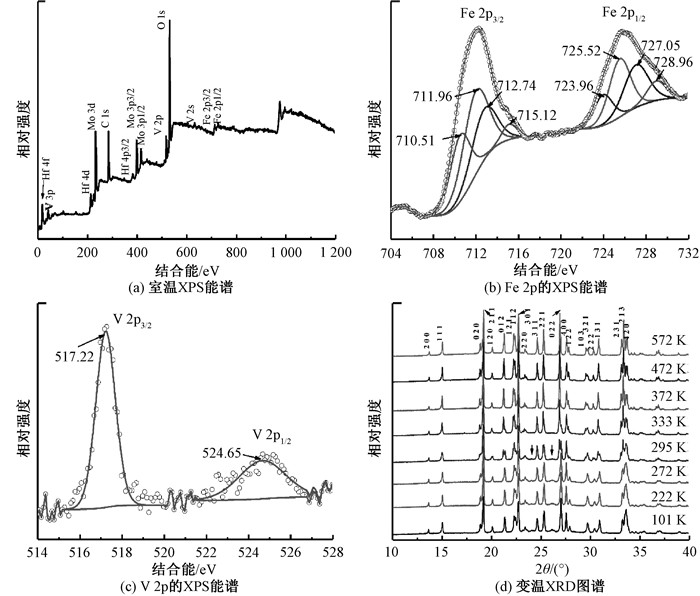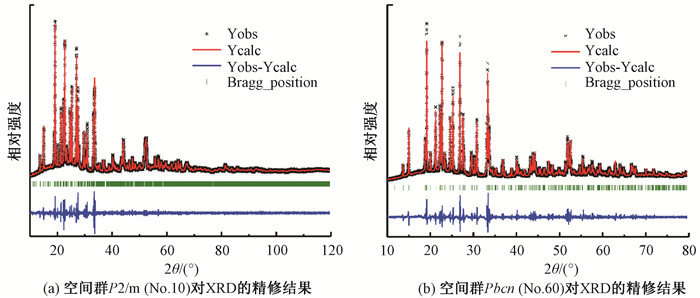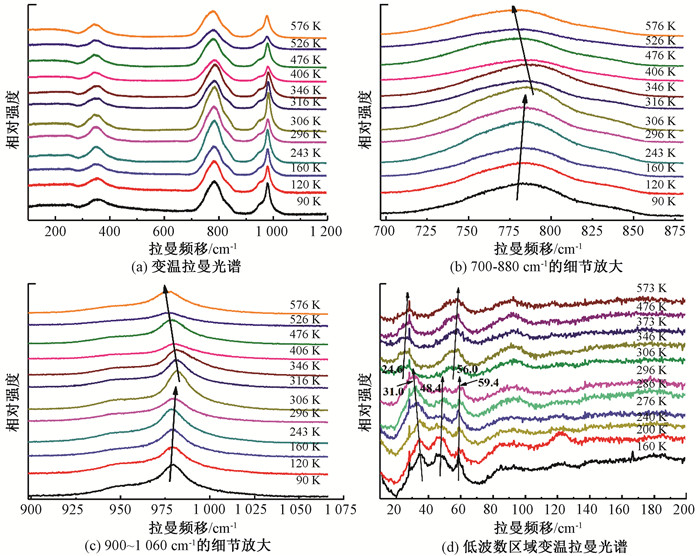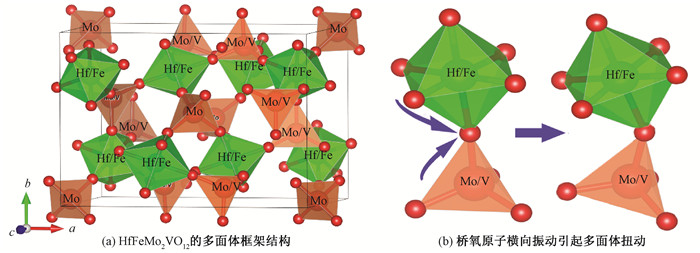2. 郑州航空工业管理学院 材料科学与工程学院 河南 郑州 450015
2. School of Materials Science and Engineering, Zhengzhou University of Aeronautics, Zhengzhou 450015, China
绝大多数材料具有热胀冷缩性质,具有相反性质的材料则较为罕见。热膨胀系数的失配会导致材料或器件内部产生热应力,引起材料或器件的性能下降、断裂甚至永久性损伤。负热膨胀材料的发现为解决这一难题提供了可能性,因而引起人们的广泛关注。近年来,人们发现了一系列具有负热膨胀性质的材料,如MF3[1-4]、AMO5[5-6]、AM2O7[7-9] (A=Zr, Hf; M=V, P)、AM2O8[10-17] (A=Zr, Hf; M=W, Mo)与A2M3O12[18-27] (A=过渡金属或稀土元素; M=W, Mo)系列材料等。
虽然负热膨胀材料的研究取得了许多进展,但仍然存在不少需要解决的问题,如某些材料只在很窄的温度范围内或仅在高温或低温下表现出负热膨胀性质,如ZrV2O7[9]、Al2Mo3O12、Cr2Mo3O12、Fe2Mo3O12、In2Mo3O12和In2W3O12分别在375 K、473 K、658 K、772 K、608 K与525 K时发生相变,且只在高温相才有负热膨胀[19]。当A3+离子半径较大时(A=Er,Lu,Yb和Y),A2Mo3O12系列材料具有宽温区负热膨胀性质,但同时又具有吸水性[28],仅在结晶水完全释放后才表现为负热膨胀。结晶水的吸放过程引起的晶格急剧变化,使材料的力学性能下降,严重影响了实际应用。
分子式为A2Mo3O12的系列材料因其化学灵活性与负热膨胀性质,引起人们极大兴趣。研究发现A3+离子不仅可被3价离子替代,也可以同时被一个4价和一个2价离子替代,为新型负热膨胀材料的设计提供了思路。基于此概念报道的新型负热膨胀材料有HfMgW3O12[29]、HfMgMo3O12[30]、ZrMgMo3O12[31]、ZrMgW3O12、ZrMnMo3O12[32]和HfMnMo3O12[33],这些材料中只有ZrMgMo3O12表现出涵盖室温的负热膨胀性质,且不具有吸水性。可见,新型负热膨胀材料的设计和负热膨胀机制研究具有重要的意义。
在上述研究基础上,本文提出了一种分子式为HfFeMo2VO12的新型负热膨胀材料,并对其进行了制备、结构表征和热膨胀性质研究。研究结果表明这种设计思路是可行的,该材料a轴表现为热膨胀,而b轴和c轴则表现为热收缩,整体上表现为近零膨胀性质。近零膨胀材料具有较好的抗热冲击性能和应用前景。与Fe2Mo3O12相比,HfFeMo2VO12的相变温度降低了466 K,使其成为宽温区的近零膨胀材料。除对结构和热膨胀性质研究外,我们还讨论了其近零膨胀和负热膨胀机制。
1 实验使用分析纯试剂HfO2 (质量分数99%)、Fe2O3 (质量分数99%)、V2O5 (质量分数99%)和MoO3 (质量分数99.5%)作为原料,通过固相法制备HfFeMo2 VO12样品。根据目标物质摩尔比称取原料,在玛瑙研钵中混合、研磨2 h后,放入高温炉中,以5 K/min的速率加热至1 023 K并保持4 h,然后自然冷却至室温。将烧结后的粉末再进行研磨,压制成厚度为3.5 mm、直径为13 mm的圆片,再在1 023 K烧结2 h,自然冷却后得到最终样品。
使用X射线光电子能谱仪(Axis Supra,Kratos)分析样品成分和元素价态;使用X射线衍射仪(XRD)(日本Rigaku,SmartLab 3KW,Cu Kα)分析其结构,测试范围为10°~120°,测试步长为0.01°;利用FullProf软件通过LeBail法拟合分析晶胞结构和晶格常数;使用LabRAM HR Evolution拉曼光谱仪(HORIBA Jobin Yvon S.A.A.,激发波长λ为532 nm或633 nm)测试其拉曼光谱;使用膨胀仪(LINSEIS DIL L75)以5 K/min的加热速率测量样品相对长度随温度的变化。
2 结果与讨论 2.1 结构与相变为了确定样品的元素成分和比例,我们对其进行了XPS能谱测试,室温下HfFeMo2 VO12的完整XPS能谱如图 1(a)所示。能谱中可以明显观察到Hf、Fe、Mo、V和O元素的XPS峰,谱中C元素来源于油泵,不影响分析。表 1给出了XPS分析结果,Hf、Fe、Mo、V和O的原子比约为5.55:5.74:11.21:6.09:71.41,非常接近设计比例(5.88:5.88:11.76:5.88:70.59)。图 1(b)和(c)是Fe 2p和V 2p的XPS能谱,2p轨道分裂为2p3/2和2p1/2。对XPS峰分峰拟合,可以确定Fe 2p3/2的结合能分别为710.51 eV、711.96 eV、712.74 eV和715.12 eV,Fe 2p1/2的结合能分别为723.96 eV、725.52 eV、727.05 eV和728.96 eV。而V 2p3/2和V 2p1/2的结合能分别为517.22 eV和524.65 eV。XPS能谱分析表明,HfFeMo2 VO12中的Fe离子为+3价,而V仅作为V5+离子存在。

|
图 1 HfFeMo2 VO12材料的XPS能谱与变温XRD图谱 Fig. 1 XPS spectra and temperature-dependent XRD patterns of HfFeMo2 VO12 |
|
|
表 1 Hf 4d、Fe 2p、Mo 3d、V 2p和O 1s的XPS峰积分结果与原子比 Tab. 1 The integration results and atomic ratio of Hf 4d, Fe 2p, Mo 3d, V 2p and O 1s |
为了确定样品的晶体结构和相变,我们对HfFeMo2 VO12样品进行了变温XRD测试,如图 1(d)所示。当温度从295 K升至333 K时,24.1°和26.3°位置处的衍射峰消失(参见图 1(d)中的箭头),表明HfFeMo2 VO12在295~333 K温度范围内发生了结构相变。为了确定其低温相和高温相的结构,我们分别对272 K和372 K的XRD图谱进行了LeBail拟合,如图 2(a)和(b)所示。结果表明,HfFeMo2 VO12在低温下为单斜结构,空间群为P2/m(No.10),晶格参数分别为a=1.617 11(5) nm,b=0.937 03(3) nm,c=1.312 85(4) nm,α=90.000°,β=104.583(2)°,γ=90.000°,V=1.925 25(10) nm3;高温相为正交结构,空间群为Pbcn(No.60),晶格参数分别为a=1.293 03(3) nm,b=0.933 23(2) nm,c=0.942 33 (2) nm,V=1.137 11(4) nm3。

|
图 2 采用不同空间群对HfFeMo2 VO12在272 K和372 K下XRD图谱的LeBail精修 Fig. 2 LeBail fit of the XRD patterns at 272 K and 372 K using different space groups |
拉曼光谱是研究材料相变较为灵敏的手段,我们对样品进行了变温拉曼测试, 以确定HfFeMo2VO12的相变温度。图 3(a)为HfFeMo2VO12从90~576 K的变温拉曼光谱。与其他钼酸盐拉曼光谱对比[34-36],可知900~1 050 cm-1内的拉曼模归属为MO4(M=Mo或V)四面体的对称伸缩,750~950 cm-1内的拉曼模为四面体的反对称伸缩,300~400 cm-1内的拉曼模为四面体的弯曲振动,低于300 cm-1内的拉曼模为Hf(Fe)O6八面体与Mo(V)O4四面体的平动与天平动模。从图 3(b)和(c)中可以看出,随着温度从90 K增加到296 K,785 cm-1和979 cm-1附近的拉曼模逐渐向高波数移动,而在306 K以上随温度升高逐渐向低波数移动。在低波数区域(图 3(d)),48.4 cm-1和59.4 cm-1附近的拉曼模随温度升高逐渐向高波数移动,而31.0 cm-1附近的拉曼模则向低波数移动。在306 K以上,这些拉曼模消失,而新的拉曼模24.6 cm-1和56.0 cm-1出现并随温度升高向高波数移动。这些结果表明,HfFeMo2 VO12在296 K和306 K之间经历结构相变,与变温XRD的分析结果相吻合。

|
图 3 HfFeMo2 VO12的变温拉曼光谱 Fig. 3 Raman spectra of HfFeMo2 VO12 at different temperatures |
图 4(a)是根据变温XRD计算得到的HfFeMo2VO12在333~572 K温区内晶格参数随温度的变化关系。可以看出,a轴随温度的升高而增大,b轴和c轴随温度的升高而减小。计算得出a、b和c轴的膨胀系数分别为(5.30±0.33)×10-6 K-1、(-1.71±0.58)×10-6 K-1和(-1.38±0.37)×10-6 K-1。由此得到体积膨胀系数为(2.21±1.28)×10-6 K-1,线性膨胀系数为(0.74±0.43)×10-6 K-1。这些结果表明,a轴的热膨胀和b、c轴的热收缩使正交相HfFeMo2VO12具有本征的近零线性膨胀性质。图 4(b)给出膨胀仪测试的HfFeMo2VO12块体相对长度随温度的变化关系。根据其线性段计算得到其正交相的线性膨胀系数为(-0.78±0.03)×10-6 K-1 (398~750 K)。这两种测试方法均证明了正交相HfFeMo2VO12的近零膨胀性质。热膨胀曲线的起始上升段是由体积较小的单斜相到体积较大的正交相的结构相变引起的,曲线的高温急剧下降段则可能是由样品的软化造成的。

|
图 4 XRD精修所得的晶格常数和膨胀仪测得的相对长度随温度的变化 Fig. 4 Temperature dependence of unit cell parameters obtained from refinements of XRD data and relative length change measured by dilatometry |
变温XRD分析得出的热膨胀系数接近但稍大于膨胀仪测得的值。主要原因是XRD计算的膨胀系数直接反映晶胞的本征热膨胀大小,而膨胀仪测得的热膨胀系数既包括本征热膨胀贡献,也包含有外在因素如微小空洞或裂隙的影响。两种测试方法所得结果差异越小,说明样品烧结质量越高[26, 37]。
2.3 相变与热缩机理与Fe2Mo3O12在772 K以上由单斜相转变为正交相相比,我们设计的HfFeMo2 VO12在306 K左右即可发生单斜相到正交相的转变,相变温度降低约466 K。这可以归因于Hf4+ (1.33)比Fe3+(1.66)具有更小的电负性,在氧离子周围集聚更多的负电荷,使O—O之间产生更大的排斥作用,更容易引起从体积较小的单斜相到体积较大的正交相的相变,从而有效地降低HfFeMo2 VO12的相变温度[26]。
通常情况下,化学键随温度的升高而变长,键强度变弱,相应的振动能量减小,表现在拉曼光谱上是振动峰位置红移,峰宽增大,如图 3(b)和(c)中高于306 K的拉曼峰所示。拉曼光谱中的反常现象则表明材料可能发生结构相变或反常热膨胀性质,如306 K前后的拉曼谱的异常变化表明在306 K附近发生单斜相到正交相的转变。在正交相中,高波数拉曼模随温度的升高而红移,说明这些拉曼模对负热膨胀没有贡献;而低波数的拉曼模(48.4 cm-1和59.4 cm-1等)均随着温度的升高而蓝移,表明与之相应的振动是引起负热膨胀的根源。正交相HfFeMo2VO12的结构如图 5(a)所示,它是由Hf(Fe)O6八面体与Mo(V)O4四面体共顶角形成的框架结构。这些低频拉曼模对应于这些多面体的外振动,即天平动或平动,也可以理解为Hf(Fe)-O-Mo(V)链中金属原子的天平动或平动,或桥氧原子的横向振动(图 5(b)),这些非简谐振动拉近了Hf(Fe)与Mo(V)之间的间距,引起体积收缩,这就是该材料负热膨胀/近零膨胀的物理机制。这些桥氧链更倾向于沿b轴和c轴方向,这就是b轴和c轴表现为热收缩,而a轴表现为热膨胀的原因。

|
图 5 HfFeMo2 VO12的多面体结构与多面体扭动示意图 Fig. 5 The polyhedral structure and polyhedral twisting of HfFeMo2 VO12 |
采用固相法制备了一种新型近零热膨胀材料HfFeMo2VO12,并通过变温XRD、变温拉曼和膨胀仪研究了其结构、相变和热膨胀性质。研究结果表明,HfFeMo2VO12在低温下结晶为单斜相,空间群为P2/m(No.10),在306 K附近转变为正交相,空间群为Pbcn(No.60)。在正交相中,其a轴表现为热膨胀,b轴和c轴表现为热收缩,膨胀系数分别为(5.30±0.33)×10-6 K-1、(-1.71±0.58)×10-6 K-1和(-1.38±0.37)×10-6 K-1,计算得到其本征线膨胀系数为(0.74±0.43)×10-6 K-1(333~572 K),而膨胀仪测得的线膨胀系数为(-0.78±0.03)×10-6 K-1(398~750 K)。因此,正交相HfFeMo2VO12为近零膨胀材料。与Fe2Mo3O12相比,HfFeMo2VO12的相变温度降低了约466 K,使其成为宽温区的近零膨胀材料。变温拉曼光谱研究显示,Hf(Fe)-O-Mo(V)链中金属原子的平动和天平动或桥氧原子的横向振动是该材料产生负热膨胀或近零膨胀的原因。
| [1] |
LI C W, TANG X L, MUÑOZ J A, et al. Structural relationship between negative thermal expansion and quartic anharmonicity of cubic ScF3[J]. Physical review letters, 2011, 107(19): 195504. DOI:10.1103/PhysRevLett.107.195504 (  0) 0) |
| [2] |
MORELOCK C R, GALLINGTON L C, WILKINSON A P. Solid solubility, phase transitions, thermal expansion, and compressibility in Sc1-x Alx F3[J]. Journal of solid state chemistry, 2015, 222: 96-102. DOI:10.1016/j.jssc.2014.11.007 (  0) 0) |
| [3] |
GREVE B K, MARTIN K L, LEE P L, et al. Pronounced negative thermal expansion from a simple structure: cubic ScF3[J]. Journal of the American chemical society, 2010, 132(44): 15496-15498. DOI:10.1021/ja106711v (  0) 0) |
| [4] |
YANG C, TONG P, LIN J C, et al. Size effects on negative thermal expansion in cubic ScF3[J]. Applied physics letters, 2016, 109(2): 023110. DOI:10.1063/1.4959083 (  0) 0) |
| [5] |
WANG X W, HUANG Q Z, DENG J X, et al. Phase transformation and negative thermal expansion in TaVO5[J]. Inorganic chemistry, 2011, 50(6): 2685-2690. DOI:10.1021/ic200003n (  0) 0) |
| [6] |
PALATNIKOV M N, SHCHERBINA O B, FROLOV A A, et al. Effect of high-intensity light on the micro- and nanostructuring and thermal expansion of Ta2O5 and Nb2O5 ceramics[J]. Inorganic materials, 2010, 46(6): 683-690. DOI:10.1134/S002016851006021X (  0) 0) |
| [7] |
WENG Z H, MURATSUGU S, ISHIGURO N, et al. Preparation of surface molecularly imprinted Ru-complex catalysts for asymmetric transfer hydrogenation in water media[J]. Dalton transactions, 2011, 40(10): 2338-2347. DOI:10.1039/C0DT00950D (  0) 0) |
| [8] |
LIU Q Q, YANG J, RONG X Q, et al. Structural, negative thermal expansion and photocatalytic properties of ZrV2O7: a comparative study between fibers and powders[J]. Materials characterization, 2014, 96: 63-70. DOI:10.1016/j.matchar.2014.07.001 (  0) 0) |
| [9] |
WITHERS R L, EVANS J S O, HANSON J, et al. Anin situtemperature-dependent electron and X-ray diffraction study of structural phase transitions in ZrV2O7[J]. Journal of solid state chemistry, 1998, 137(1): 161-167. DOI:10.1006/jssc.1998.7748 (  0) 0) |
| [10] |
ERNST G, BROHOLM C, KOWACH G R, et al. Phonon density of states and negative thermal expansion in ZrW2O8[J]. Nature, 1998, 396(6707): 147-149. DOI:10.1038/24115 (  0) 0) |
| [11] |
MARY T A, EVANS J S O, VOGT T, et al. Negative thermal expansion from 0.3 to 1 050 Kelvin in ZrW2O8[J]. Science, 1996, 272(5258): 90-92. DOI:10.1126/science.272.5258.90 (  0) 0) |
| [12] |
EVANS J S O, MARY T A, VOGT T, et al. Negative thermal expansion in ZrW2O8 and HfW2O8[J]. Chemistry of materials, 1996, 8(12): 2809-2823. DOI:10.1021/cm9602959 (  0) 0) |
| [13] |
YAMAMURA Y, NAKAJIMA N, TSUJI T. Calorimetric and X-ray diffraction studies of α-to-β structural phase transitions in HfW2O8 and ZrW2O8[J]. Physical review B, 2001, 64(18): 184109. DOI:10.1103/PhysRevB.64.184109 (  0) 0) |
| [14] |
PRYDE A K A, HAMMONDS K D, DOVE M T, et al. Origin of the negative thermal expansion in ZrW2O8 and ZrV2O7[J]. Journal of physics: condensed matter, 1996, 8(50): 10973-10982. DOI:10.1088/0953-8984/8/50/023 (  0) 0) |
| [15] |
NAKAJIMA N, YAMAMURA Y, TSUJI T. Phase transition of negative thermal expansion Zr1-xHfxW2O8 solid solutions[J]. Journal of thermal analysis and calorimetry, 2002, 70(2): 337-344. DOI:10.1023/A:1021647717948 (  0) 0) |
| [16] |
LIND C, WILKINSON A P, HU Z B, et al. Synthesis and properties of the negative thermal expansion material cubic ZrMo2O8[J]. Chemistry of materials, 1998, 10(9): 2335-2337. DOI:10.1021/cm980438m (  0) 0) |
| [17] |
JORGENSEN J D, HU Z, SHORT S, et al. Pressure-induced cubic-to-orthorhombic phase transformation in the negative thermal expansion material HfW2O8[J]. Journal of applied physics, 2001, 89(6): 3184-3188. DOI:10.1063/1.1347412 (  0) 0) |
| [18] |
TYAGI A K, ACHARY S N, MATHEWS M D. Phase transition and negative thermal expansion in A2(MoO4)3 system (A=Fe3+, Cr3+ and Al3+)[J]. Journal of alloys and compounds, 2002, 339(1/2): 207-210. (  0) 0) |
| [19] |
SLEIGHT A W, BRIXNER L H. A new ferroelastic transition in some A2(MO4)3 molybdates and tungstates[J]. Journal of solid state chemistry, 1973, 7(2): 172-174. DOI:10.1016/0022-4596(73)90152-7 (  0) 0) |
| [20] |
MARY T A, SLEIGHT A W. Bulk thermal expansion for tungstate and molybdates of the type A2M3O12[J]. Journal of materials research, 1999, 14(3): 912-915. DOI:10.1557/JMR.1999.0122 (  0) 0) |
| [21] |
MARINKOVIC B A, JARDIM P M, DE AVILLEZ R R, et al. Negative thermal expansion in Y2Mo3O12[J]. Solid state sciences, 2005, 7(11): 1377-1383. DOI:10.1016/j.solidstatesciences.2005.08.012 (  0) 0) |
| [22] |
MARINKOVIC B A, ARI M, DE AVILLEZ R R, et al. Correlation between AO6 polyhedral distortion and negative thermal expansion in orthorhombic Y2Mo3O12 and related materials[J]. Chemistry of materials, 2009, 21(13): 2886-2894. DOI:10.1021/cm900650c (  0) 0) |
| [23] |
LIANG E J, HUO H L, WANG J P, et al. Effect of water species on the phonon modes in orthorhombic Y2(MoO4)3 revealed by Raman spectroscopy[J]. The journal of physical chemistry C, 2008, 112(16): 6577-6581. DOI:10.1021/jp8013332 (  0) 0) |
| [24] |
FORSTER P M, YOKOCHI A, SLEIGHT A W. Enhanced negative thermal expansion in Lu2W3O12[J]. Journal of solid state chemistry, 1998, 140(1): 157-158. DOI:10.1006/jssc.1998.7967 (  0) 0) |
| [25] |
EVANS J S O, MARY T A, SLEIGHT A W. Negative thermal expansion in Sc2(WO4)3[J]. Journal of solid state chemistry, 1998, 137(1): 148-160. DOI:10.1006/jssc.1998.7744 (  0) 0) |
| [26] |
EVANS J S O, MARY T A, SLEIGHT A W. Negative thermal expansion in a large molybdate and tungstate family[J]. Journal of solid state chemistry, 1997, 133(2): 580-583. DOI:10.1006/jssc.1997.7605 (  0) 0) |
| [27] |
EVANS J S O, MARY T A. Structural phase transitions and negative thermal expansion in Sc2(MoO4)3[J]. International journal of inorganic materials, 2000, 2(1): 143-151. DOI:10.1016/S1466-6049(00)00012-X (  0) 0) |
| [28] |
SONG W B, YUAN B H, LIU X S, et al. Tuning the monoclinic-to-orthorhombic phase transition temperature of Fe2Mo3O12 by substitutional co-incorporation of Zr4+ and Mg2+[J]. Journal of materials research, 2014, 29(7): 849-855. DOI:10.1557/jmr.2014.63 (  0) 0) |
| [29] |
LI T, LIU X S, CHENG Y G, et al. Zero and controllable thermal expansion in HfMgMo3-xWxO12[J]. Chinese physics B, 2017, 26(1): 016501. DOI:10.1088/1674-1056/26/1/016501 (  0) 0) |
| [30] |
MARINKOVIC B A, JARDIM P M, ARI M, et al. Low positive thermal expansion in HfMgMo3O12[J]. Physica status solidi (b), 2008, 245(11): 2514-2519. DOI:10.1002/pssb.200880262 (  0) 0) |
| [31] |
SONG W B, LIANG E J, LIU X S, et al. A negative thermal expansion material of ZrMgMo3O12[J]. Chinese physics letters, 2013, 30(12): 126502. DOI:10.1088/0256-307X/30/12/126502 (  0) 0) |
| [32] |
GE X H, MAO Y C, LI L, et al. Phase transition and negative thermal expansion property of ZrMnMo3O12[J]. Chinese physics letters, 2016, 33(4): 046503. DOI:10.1088/0256-307X/33/4/046503 (  0) 0) |
| [33] |
LIU Y, YUAN B, CHENG Y, et al. Phase transition and negative thermal expansion of HfMnMo3O12[J]. Materials research bulletin, 2018, 99: 255-259. DOI:10.1016/j.materresbull.2017.11.009 (  0) 0) |
| [34] |
PARAGUASSU W, MACZKA M, FILHO A G S, et al. A comparative study of negative thermal expansion materials Sc2(MoO4)3 and Al2(WO4)3 crystals[J]. Vibrational spectroscopy, 2007, 44(1): 69-77. DOI:10.1016/j.vibspec.2006.08.006 (  0) 0) |
| [35] |
LIEGEOIS-DUYCKAERTS M, TARTE P. Vibrational studies of molybdates, tungstates and related compounds—Ⅱ: new Raman data and assignments for the scheelite-type compounds[J]. Spectrochimica acta part A: molecular spectroscopy, 1972, 28(11): 2037-2051. DOI:10.1016/0584-8539(72)80178-8 (  0) 0) |
| [36] |
MACZKA M, HERMANOWICZ K, HANUZA J. Phase transition and vibrational properties of A2(BO4)3 compounds (A=Sc, In; B=Mo, W)[J]. Journal of molecular structure, 2005, 744: 283-288. (  0) 0) |
| [37] |
PRISCO L P, ROMAO C P, RIZZO F, et al. The effect of microstructure on thermal expansion coefficients in powder-processed Al2Mo3O12[J]. Journal of materials science, 2013, 48(7): 2986-2996. DOI:10.1007/s10853-012-7076-9 (  0) 0) |
 2020, Vol. 52
2020, Vol. 52

